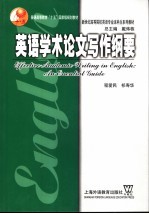图书介绍
英语学术论文写作纲要pdf电子书版本下载

- 程爱民,祁寿华编著 著
- 出版社: 上海:上海外语教育出版社
- ISBN:7810956817
- 出版时间:2005
- 标注页数:263页
- 文件大小:11MB
- 文件页数:277页
- 主题词:英语-论文-写作-高等学校-教材
PDF下载
下载说明
英语学术论文写作纲要PDF格式电子书版下载
下载的文件为RAR压缩包。需要使用解压软件进行解压得到PDF格式图书。建议使用BT下载工具Free Download Manager进行下载,简称FDM(免费,没有广告,支持多平台)。本站资源全部打包为BT种子。所以需要使用专业的BT下载软件进行下载。如 BitComet qBittorrent uTorrent等BT下载工具。迅雷目前由于本站不是热门资源。不推荐使用!后期资源热门了。安装了迅雷也可以迅雷进行下载!
(文件页数 要大于 标注页数,上中下等多册电子书除外)
注意:本站所有压缩包均有解压码: 点击下载压缩包解压工具
图书目录
PART Ⅰ GENERAL FEATURES OF ACADEMIC WRITING 3
Chapter 1 Academic Writing:An Introduction 3
1.1 Academic Writing:A Definition 3
1.2 Characteristics of Good Academic Writing 5
1.2a Good Writing Calls for Critical Reading and Critical Thinking 6
1.2b Good Writing Involves Thoughtful Revision 7
1.2c Good Writing Is Directed Toward an Audience 8
1.2d Good Writing Achieves a Clear Purpose 9
1.2e Good Writing Expresses Ideas Clearly 9
1.2f Good Writing Pulses with Creativity 10
Chapter 2 Kinds of Academic Writing 12
2.1 Writing to Summarize 12
2.2 Writing to Synthesize 16
2.3 Writing to Explain 19
2.3a Writing to Inform 21
2.3b Writing to Explain Processes 23
2.3c Writing to Explain Concepts 25
2.4 Writing to Argue 28
2.4a The Logical Appeal 29
2.4b The Emotional Appeal 30
2.4c The Ethical Appeal 30
2.4d Five Basic Components 31
2.5 Writing to Propose 34
2.6 Writing to Analyze 36
2.7 Writing to Evaluate 38
Chapter 3 The Rhetorical Context and Characteristics of Academic Writing 42
3.1 The Rhetorical Context 43
3.1a Topic or Subject 43
3.1b Audience 44
3.1c Purpose and Role 48
3.2 Characteristics of Academic Papers 49
4.1 Process of Writing 55
Chapter 4 Finding a Topic 55
PART Ⅱ PROCESS OF EFFECTIVE ACADEMIC WRITING 55
4.2 Assessing Your Prior Interest and Knowledge 57
4.3 Narrowing the Topic—Creating a Good Title 59
4.4 Techniques for Inventing 61
4.4a Freewriting 62
4.4b Brainstorming 63
4.4c Branching 64
4.4d Cubing 64
4.4e Questioning or Journalistic Formula 66
4.5 Generating New Ideas by Critical Reading 67
Chapter 5 Researching the Topic 69
5.1 Field Research 70
5.1a Observing 71
5.1b Interviewing 73
5.1c Using Questionnaire 75
5.2a Library Sources and Materials 80
5.2 Library Research 80
5.2b Taking Notes 88
5.3 Internet Research 89
5.4 Keeping Track of Your Research 92
5.5 A Six-Step Approach to Research 94
Chapter 6 Outlining 98
6.1 The Structure of a Paper 98
6.2 Sorting Out Your Notes and Other Materials 101
6.3 Outlining 101
6.3a Draft Outline 102
6.3b Formal Outline 103
6.3c Two Commonly Used Patterns of Formal Outlines 105
6.4 Formulating the Thesis Statement 108
Chapter 7 Drafting,Revising,Editing and Proofreading 111
7.1 Drafting 111
7.2 Revising 114
7.2a Revising for Content and Organization—Macro-revision 115
7.2b Revising for Details—Micro-revision 116
7.3 Final Editing and Proofreading 122
PART Ⅲ STRATEGIES FOR EFFECTIVE ACADEMIC WRITING 127
Chapter 8 Organizing the Paper 127
8.1 Five Basic Organizational Patterns 129
8.1a General-to-Specific/Abstract-to-Concrete 129
8.1b Specific-to-General/Concrete-to-Abstract 132
8.1c Order of Importance 134
8.1d Chronological Order 135
8.1e Spatial Order 136
8.1f Other Organizational Patterns 138
8.2 Introduction 139
8.2a Narrative 140
8.2b Descriptive 141
8.2c Preparatory 143
8.2d Corrective 145
8.2e Inquisitive 146
8.2f Stating a Problem 147
8.2g Giving a Surprising Fact or Statistics 148
8.2h Using a Striking Quote 150
8.3 Conclusion 150
8.3a Restating the Main Points 151
8.3b Referring Back to the Thesis(and the Introduction) 151
8.3c Suggesting a Solution,Further Study,or Predicting an Out-come 152
8.3d Giving a Humorous Comment or Unexpected Twist 152
8.3e Using a Striking or Memorable Quote 153
Chapter 9 Strategies for Development 155
9.1 Definition 156
9.1a Sentence Definition 157
9.1b Extended Definition 158
9.1c Historical Definition 158
9.1d Stipulative Definition 159
9.2 Classification 160
9.2a Choosing the Principle(s)to Classify 161
9.2b Testing the Effectiveness 162
9.2c Explaining Each Subgroup 164
9.3 Example 166
9.3a Relevant Examples 167
9.3b Specific Examples 168
9.3c Sufficient Examples 169
9.4 Comparison and Contrast 170
9.4a Points for Comparing and Contrasting 170
9.4b Two Ways for Organizing Comparison and Contrast 172
9.4c Transitional Words and Phrases 175
9.5 Cause and Effect 176
9.5a Distinguishing Between Cause and Effect 176
9.5b Necessity,Sufficiency,and Mill's Methods 179
9.5c Organizing Cause and Effect Analysis 181
9.6 Generalization 186
9.5d Transitional Words and Phrases for Cause-and-Effect Analysis 186
9.7 Visual Elements 187
Chapter 10 Use of Sources and Documentation 189
10.1 Importance of Using and Documenting Sources 189
10.2 Three Ways to Use Sources 190
10.3 Styles of Documentation 193
10.4 MLA Style 194
10.4a In-text Citation 194
10.4c List of Works Cited 196
10.4b Explanatory Notes 196
10.5 APA Style 202
10.5a In-text Citation 203
10.5b Explanatory Notes 204
10.5c List of References or Bibliography 204
10.6 中文参考文献格式 210
Appendix:Sample Student Acaademic Writings 211
Works Cited and Consulted 263